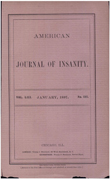SPECT study of regional cerebral perfusion in neuroleptic-resistant schizophrenic patients who responded or did not respond to clozapine
Abstract
OBJECTIVE: The purpose of this study was to find predictive criteria for response to clozapine. METHOD: Single photon emission computed tomography studies of cerebral perfusion were done in 24 treatment- resistant schizophrenic patients while they were taking typical neuroleptics and again after they had been treated with clozapine for 6 months. Perfusion ratios of the subjects categorized as responders or nonresponders to clozapine and of the subjects in the two treatment conditions were compared. The ratios with significant between-group differences were compared to those from a normal database. RESULTS: Before clozapine, while taking neuroleptics, subjects who became responders to clozapine showed higher thalamic, left basal ganglia, and right prefrontal perfusion. Nonresponders to clozapine had lower prefrontal perfusion and responders had higher subcortical perfusion than subjects in the normal database. The subcortical perfusion of the responders decreased when they received clozapine. CONCLUSIONS: The study of cerebral perfusion may contribute to the prediction of response to clozapine.
Access content
To read the fulltext, please use one of the options below to sign in or purchase access.- Personal login
- Institutional Login
- Sign in via OpenAthens
- Register for access
-
Please login/register if you wish to pair your device and check access availability.
Not a subscriber?
PsychiatryOnline subscription options offer access to the DSM-5 library, books, journals, CME, and patient resources. This all-in-one virtual library provides psychiatrists and mental health professionals with key resources for diagnosis, treatment, research, and professional development.
Need more help? PsychiatryOnline Customer Service may be reached by emailing [email protected] or by calling 800-368-5777 (in the U.S.) or 703-907-7322 (outside the U.S.).



